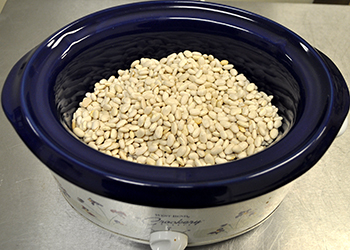Do Not Cook Dry Beans in Your Slow Cooker
Return to Heath and Nutrition Agent Articles
 The slow cooker is a staple tool at my house especially during these wintry months. It’s low and slow, cook-it-all-day technique makes it a perfect vessel for turning tough ingredients into tender deliciousness. But research now suggests that one tough ingredient shouldn’t be cooked in the slow cooker at all — beans.
The slow cooker is a staple tool at my house especially during these wintry months. It’s low and slow, cook-it-all-day technique makes it a perfect vessel for turning tough ingredients into tender deliciousness. But research now suggests that one tough ingredient shouldn’t be cooked in the slow cooker at all — beans.
All beans contain a compound called “phytohaemagglutinin,” also called PHA, or kidney bean lectin. Lectin is a type of protein that performs many functions in both plants and animals. But some types of lectin, including this one, can be toxic at high levels.
If this lectin isn’t destroyed by thorough cooking, you’ll be sorry. According to the U.S. Food and Drug Administration’s Bad Bug Book , eating as few as four or five improperly cooked red kidney beans can cause severe vomiting within a few hours, followed by diarrhea. Other symptoms include serious abdominal pain.
Although some cases have required hospitalization, people normally feel better within three to four hours after symptoms start. That’s one reason why there aren’t many recorded cases of this particular foodborne illness in the U.S.: People usually begin to get over the illness just about the time they might think of contacting their doctor.
Other types of beans also contain PHA, but it’s much more concentrated in red kidney beans. For example, the unit of measurement for the toxin is called “hau,” for “hemagglutinating unit.” Raw red kidney beans have anywhere from 20,000 to 70,000 hau, but that drops to 200 to 400 hau when the beans are fully cooked — not enough to be a problem. White kidney beans, or cannellini beans, contain only about one-third of the toxin as red kidney beans. Broad beans, or fava beans, contain just 5 to 10 percent of what’s in red kidney beans.
The FDA recommends these steps for preparing dry red kidney beans:
- Soak beans for at least five hours in water. Change the water periodically, but it’s not necessary for safety.
- Drain the beans from the final soaking water.
- Boil beans in fresh water for at least 30 minutes. Note: The toxin is destroyed when boiled at 212ºF for 10 minutes, but scientists recommend 30 minutes to be certain the beans reach the proper temperature for the amount of time necessary.
- Don’t use a slow cooker. It likely won’t get hot enough.
Source: https://www.fda.gov/food/foodborne-pathogens/bad-bug-book-second-edition
Want more great food tips, recipes and nutrition info?
Sign up to receive In Good Health each month in your email inbox.
Contact Us